Abstract
The article presents the author's approach to solving the actual scientific and practical problem of forming a mechanism of digital transformation of small and medium-sized enterprises. The innovative digital transformation of a commercial company is suggested to be considered as such a functioning of the business system, in which it reaches a fundamentally higher level of business processes digitalization. The formulated suggestions are based on structural and logical modeling of business processes of digital transformation of the enterprise. The classification of the main business processes is considered and the corresponding typological groups of digital innovations for effective digital transformation are suggested. It is shown that the real digital transformation of business processes is based on the corresponding intra-company program of organizational, technical, and technological changes in the business management system. It is necessary to rely on a program-target approach that allows linking the program goals, related tasks, a set of planned activities and the necessary resources. The basic and procedural models for managing the digital transformation of the main business processes of an enterprise are suggested. It allows specialists to carry out practical development of innovative development programs of enterprises. The main scientific result of the research is a set of structural and logical models that provide the opportunity to develop internal documents of planning and managing the processes of digital transformation of an enterprise on their basis.
Keywords: Digital transformationinnovationsmodelingprocessesprogram
Introduction
The current economic situation in the Russian economy makes it necessary for many small and medium-sized enterprises to undergo a radical digital transformation, i.e. a transformation of all the company's business processes that allows for the integrated use of modern information and communication technologies at all levels of the business management system. This is due to increasing competition in various segments of the economy and a sharp rise in the value of digital technologies in the development and creation of new commercially effective business forms. Innovative digital transformation of a commercial company should be considered as a functioning of the business system, in which it reaches a fundamentally higher level of business processes digitalization. In a broad sense, the company's digital transformation makes it an element of the global cyber-physical system industrie 4.0, which provides for the use of artificial intelligence capabilities, full automation, and reducing the role of human in production and business processes (Bashaeva, 2019). Of particular interest for the innovative development of enterprises is the prospect of implementing fundamentally new technological platforms for business (Chin, 2019). To assess the priority of digital innovations in the transformation of the company, you can use the suggested classification and division of business processes into appropriate typological groups, which are presented in Figure
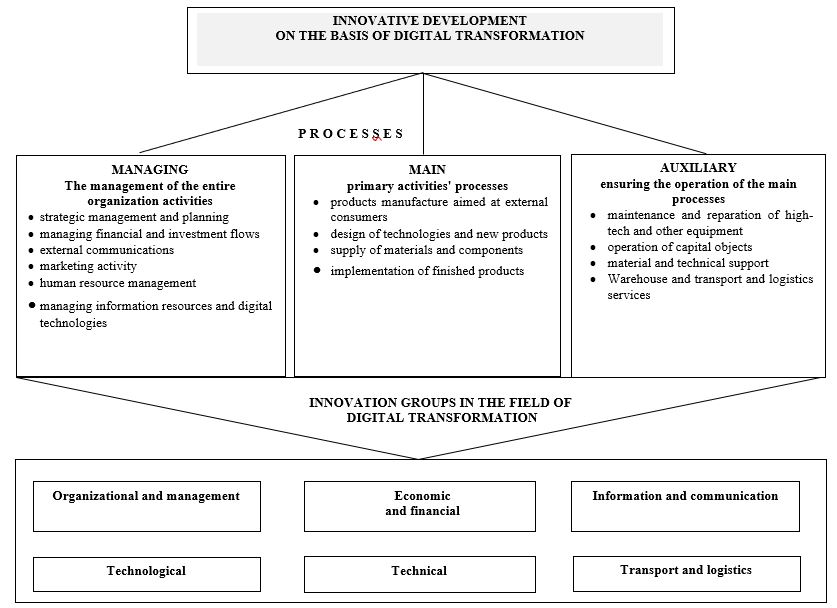
The suggested main typological groups of digital innovations suggest their further differentiation, taking into account the specifics of particular enterprises. Innovation development of the enterprise is based on interrelated internal processes of the business system functioning. It is logical to present process-oriented enterprise management as the main mechanism for reducing the level of uncertainty and confusion in the process of adapting digital technologies to the business system (Zhigalova, 2007).
Problem Statement
The ability to influence the process of innovative transformation of the company for the purposes of digital transformation can be provided through a program-target management mechanism using process, organizational, financial, economic, information and other approaches. The digital transformation of a particular company is based on a corresponding internal program of organizational and technical and technological changes in the business management system (hereinafter referred to as the program). The preparation of the program for justification, development and implementation of measures of digital transformation of company management is advisable to focus on the program-objective methods in planning and control, which allows linking the program goals, relevant tasks, a set of planned activities and resources that ensure the achievement of set goals. A variant of structuring a program for justification, development and implementation of measures of digital transformation of company management is shown in Figure
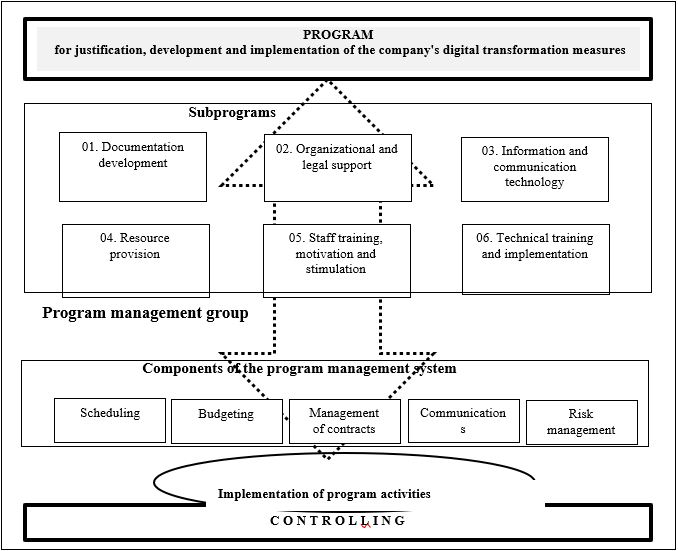
The program structure is a set of interrelated and interacting sets of subprograms (activities, projects) that ensure the achievement of its main goal. The program implement the following main tasks:
–description of the program content, definition of stages and main subprograms with their decomposition into manageable elements;
–identification of activities (projects) that ensure the achievement of the program goal;
–formation of an organizational mechanism for managing and controlling the implementation of the program;
–estimation of the duration and cost of program activities.
Implementation of the tasks of digital transformation of company management can be carried out within the framework of the proposed dynamic cycle of project and process program management (Figure
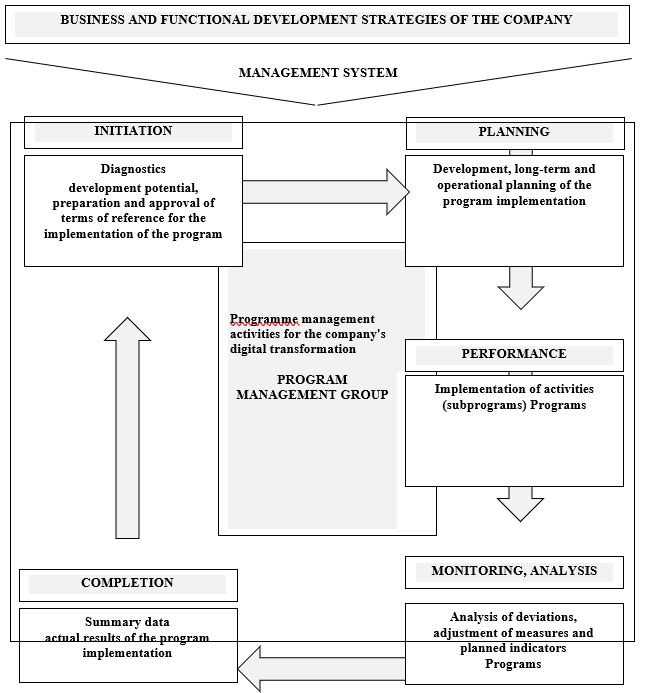
Research Questions
The digital development processes of each commercial company have their own specifics, determined by a number of factors of an industrial, regional and intra-production nature. Accordingly, in terms of methodology, it is advisable to study and justify the basic approaches (structural schemes) to the process of digital transformation of the enterprise. Digital transformation of an enterprise's business processes requires goal-setting that allows to formulate an appropriate business strategy for digital development of the enterprise. The dynamic nature of processes that affect the ways of management decisions making is considered. The complex solution of problems of the enterprise's business processes digitalization is based on the program-targeted approach. Within the framework of the program-targeted approach, program goals, corresponding tasks (subprograms), planned activities and necessary resources are interconnected. The key issue for the research of the algorithm for implementing digital transformation program measures can be considered as a scientific and methodological justification of the corresponding basic and procedural models for managing digital transformation of the company's main business processes.
Purpose of the Study
The study of the company's digital transformation processes is aimed at creating a mechanism for managing the innovative development of the business system, in which it reaches a higher level of quality and productivity of business processes. The purpose of the study is to analyze, substantiate and form a set of structural and logical models for managing digital transformations of business processes. Structural and logical models (schematic diagrams) should provide an opportunity to develop internal documents for planning and managing the processes of digital transformation of the enterprise on their basis. In this direction, the basic (principal) and procedural models of managing the digital transformation of an enterprise are justified.
Using structural and logical models allows specialists to form a real algorithm for developing, implementing and monitoring the program of innovative digital development of enterprises. At the same time, a business process management structure is formed in which each control element provides internal innovations and responds adequately to changes in the structure of the entire business system. On the basis of the procedural model, the functioning of a specially formed and constantly operated management element (the digital transformation program management group) is justified. In general, the studies are aimed at expanding the conceptual and instrumental apparatus that provides a methodically sound approach to program-targeted digital development of small and medium-sized enterprises.
Research Methods
For the purpose of studying the mechanism of innovative digital development of the enterprise business system, analytical and instrumental methods of structural and logical schematization and economic modeling were used. For research and subsequent analysis of the processes of managing innovative development of enterprises, data is collected on the methods and forms of digital transformation applied to various forms of business. On this basis, we analyze options for actions algorithms that ensure the most effective digital transformation of enterprises. The use of structural and logical schematization makes it possible to carry out economic modeling of the processes of digital transformation of enterprises in the form of schematic diagrams of the actions sequence of specialists in managing the innovative development of business systems. The recommendations for digital transformation of enterprises are based on a program-oriented approach that provides justification, development, implementation, control and introduction of innovative changes in business practices within a repeating dynamic cycle. To study the digital transformation process, we use the concept of a digital double - a virtual process model that allows to analyze data, monitor business systems, and develop new approaches to process management using modeling (Marr, 2017). The information base of the study is based on data obtained by the author at specific enterprises, as well as a generalization of published research results of a number of specialists on the relevant topic.
Findings
Strategically oriented activities on digital transformation of the enterprise should be aimed at purposeful formation of an innovative business process management system in the information and communication environment. The basic (principal) model of strategic management of digital transformation of an enterprise is shown in Figure
The program management group is created by the decision of the company's managers with the simultaneous appointment of a responsible group leader. This group is formed as an "interagency" coordinating and managing body. It may include managers (leading specialists) of the company's divisions, representatives of external organizations involved (co-executors), as well as experts to work in certain areas of management. The main function of the program management group is to provide professional development and management of the program, which makes it possible to implement the necessary components of program management. The activities of the program management group in terms of creation goals, tasks, rights, responsibilities, official interaction and other components should be regulated by a special provision.
Information and communication support of the dynamic program management cycle is provided by proven solutions in the part of corporate information management systems, including the resource management subsystem – ERP (Cozmiuc & Petrisor, 2018). In addition, you should rely on project management, process management, quality management, customer relationship management, document management subsystems and others. It is advisable to use the modern information module BusinessObjects program (Grigoriev, 2015) for analytical assessment of the situation in the implementation of the program, in which a database is formed through the use of appropriate analytical tools, including financial, operational and other reports for better management decisions.
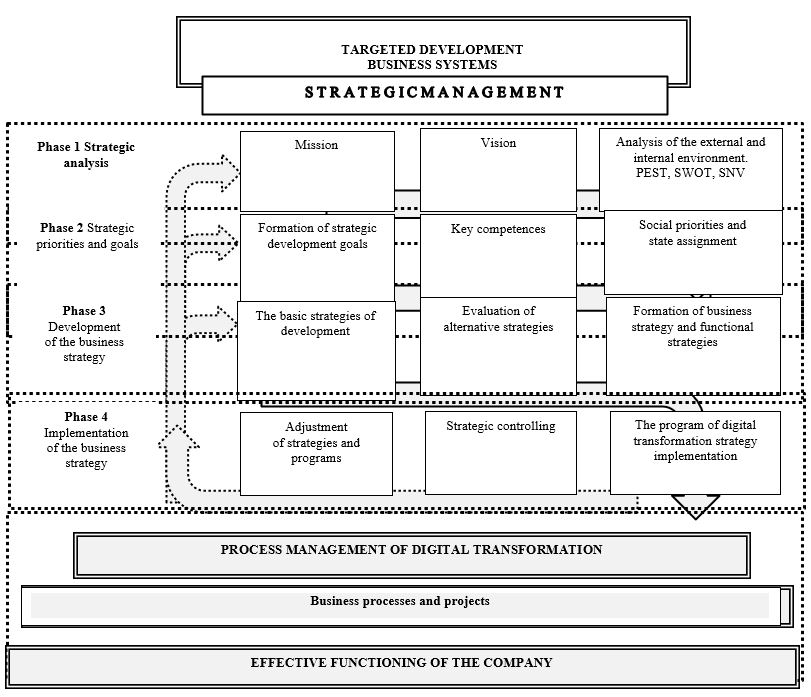
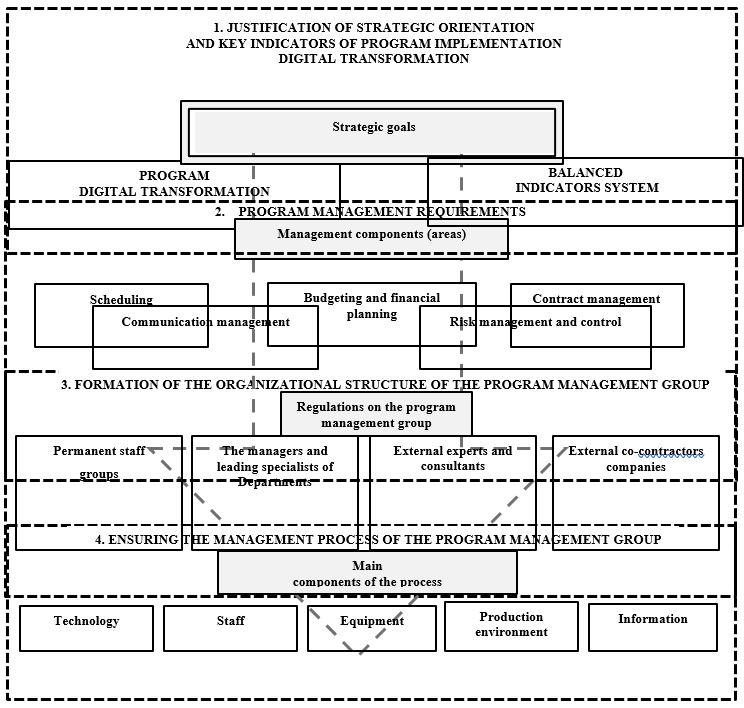
Conclusion
For the dynamic development of the Russian economy, its comprehensive digitalization is relevant. In relation to small and medium-sized businesses, it is extremely important to transform the business processes of companies in such a way as to maximize the use of modern information and communication technologies. The study showed that the digital transformation of a particular company should be based on an appropriate internal program of organizational and technical and technological changes in the business system management system. Classification of the main business processes and the proposed typological groups of digital innovations for effective digital transformation allow enterprise specialists to analyze and structure business processes to determine the priority of the program implementation stages for a particular company.
The main goal of the preparation and implementation of this program is considered to be the launch of an improved digital business process management system based on the structuring of the main tasks with the allocation of appropriate subprograms for the implementation of program activities. On the basis of monitoring and analysis, permanent monitoring of the viability of the developed program is carried out, deviations from the planned direction of development are detected, which allows managers to adapt the corresponding subprograms to a specific situation. The conducted structural and logical modeling of the company's digital transformation processes can be considered as an algorithmization of the typical activities of specialists of a particular company in organizing and managing the cycle of innovative changes.
The peculiarity of these models is that the logic of achieving the goal of digitalization of the company highlights the main phases and activities that allow you to consistently achieve the desired result. Their use makes it possible for specialists of enterprises interested in systematic work on digitalization of the company's business processes to develop internal regulations of various levels that contribute to the correct implementation of the required management actions. In this sense, the proposed procedural model for forming an organizational structure for managing a company's digital transformation program can serve as a basis for justifying and developing the required management mechanisms: management components, program management group, and elements for ensuring the management process. In general, the developed structural and logical models provide a practical opportunity for company specialists to develop internal documents for planning and managing the processes of digital business transformation on their basis.
References
- Bashaeva, M. A. (2019). "Industry 4.0" in Russia: At the threshold of an industrial revolution. Young Scientist, 13(251), 100-102.
- Chin, D. (2019). Making the most of your IIoT transformation. https://www.industryweek.com/technology-and-iiot/article/22027003/making-the-most-of-your-iiot-transformation
- Cozmiuc, D., & Petrisor, I. (2018). Industrie 4.0 by Siemens: Steps made next. Journal of Cases on Information Technology, 20(1), 31-45.
- Grigoriev, A. A. (2015). The functionality of SAP business objects. Plekhanov Russian University of Economics, 3(21), 1-23.
- Marr, B. (2017). What is digital twin technology - And why is it so important? https://www.forbes.com/sites/bernardmarr/2017/03/06/what-is-digital-twin-technology-and-why-is-it-so-important
- Zhigalova, V. N. (2007). The role of innovation in the modern concept of economic development. Management of Social and Economic Systems, 1. https://works.doklad.ru/view/5BMTgSpANO0.html
Copyright information

This work is licensed under a Creative Commons Attribution-NonCommercial-NoDerivatives 4.0 International License.
About this article
Publication Date
30 April 2021
Article Doi
eBook ISBN
978-1-80296-105-8
Publisher
European Publisher
Volume
106
Print ISBN (optional)
-
Edition Number
1st Edition
Pages
1-1875
Subjects
Socio-economic development, digital economy, management, public administration
Cite this article as:
Akopyan, D. A., Kurakova, C. M., & Prygunova, M. I. (2021). Formation Of A Digital Transformation Mechanism Of Small And Medium-Sized Enterprises. In S. I. Ashmarina, V. V. Mantulenko, M. I. Inozemtsev, & E. L. Sidorenko (Eds.), Global Challenges and Prospects of The Modern Economic Development, vol 106. European Proceedings of Social and Behavioural Sciences (pp. 354-362). European Publisher. https://doi.org/10.15405/epsbs.2021.04.02.43

